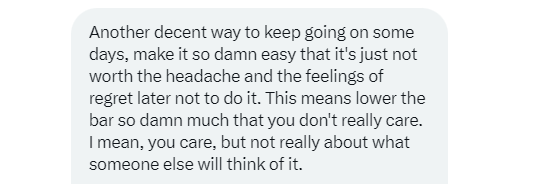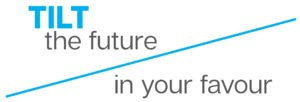When the Muse Refuses to Speak to You
E73: Challenged for content or rhythm? Crowd sourced ideas to build a sustainable newsletter process
Read this if:
You find yourself lacking momentum. You want to keep publishing essays or newsletters on a specific frequency
You sit down to a blank page many weeks. You’d like some content ideas.
You have been following all the sage advice out there, and it is not working for you. What gives? Are you feeling stupid, like you are the only one on earth who does not get it?
There are weeks when you come to create, and … NOTHING. You’ve hit a slump. Everyone does. This edition is about pacing and includes crowd-sourced ideas on how to handle it.
TL;DR
Expect the dip. Plan ahead so you don’t get caught out.
Look for advice from others, but customize it to suit you.
If you are looking for accountability partners, check if that fits your Tendency profile. It is not a strategy that works for Rebels.
Create a sustainable cycle that includes recovery and learning.
Put some automatic behaviours in place.
Get personal.
When all else fails, cheat. In the newsletter equivalent of bubble and squeak, work with your leftovers, and repurpose old content for fresh eyes.
Getting Through the Dip
There is a moment after a class or workshop when the buzz fades, and now you are just stuck “doing the work” that you came in to learn. It could be podcasting, publishing, or video. What do you do when “The Dip” finds you?
I know what it is like to collect, read and implement (productivity and procrastination-busting) idea after idea … and still not get anywhere. I spent many years wondering what was wrong with me. What was I doing wrong?
Creating a sustainable process
When I look back there are a few elements that make this time stick for me - so far. (This is edition 73)
So far. Realizing that what works right now, may not continue to work forever. So I give myself grace. (Wisdom that comes with experience and age!) I work in cycles of seven, and watch my engagement during that cycle. Did I add interest to your life? When new subscriptions and open rate continue to go up, then I take that as a sign that I stick with it for another cycle. But did I add value? When the comments and DMs reflect that, I get sparked to stick around for more than just one cycle.
Cycle of Seven. Three? Five? One Hundred? I'm looking at you
The number does not matter. I committed to three cycles of seven before evaluating if this was something I wanted to continue. It allowed me to develop a sustainable process. Two words. Sustainable. Process. In the words of "make this easy, SO EASY that it's just not worth the headache and feelings of regret later not to do it." The newsletter (or other practice) should not run your life.
Planned my next cycle ahead using the basic prompt types: I take a few moments to come up with a loose structure for the upcoming 7 editions. The seventh is automatically a curation of the previous six. I can also use calendar events such as year-end and Valentine’s Day to guide my content. (Video length 1:43 @1x)
Planned ahead for the Dip: Know that it will happen. It is inevitable. And happens to everyone. If it isn’t a pre-planned vacation, it is a sick child. The solution? Have a few easy content ideas in your back pocket. Listicles (Top 10, My favourite five) are simple. Repurpose a post or thought from a few years back. For loyal subscribers it is like re-opening a book to a familiar page. For your new subscribers, it is fresh material. Really stuck? Go personal with a photo, a family joke, or a recipe.
What Automatic Behaviours can you implement? My friend Sana Fayaz created a constraint of no more than 500 words. Kathy Karn commits to Wednesdays (because that is hump day, and animal photos always put a smile on our faces!) Automatic behaviours prevent decision fatigue. They reduce the number of decisions you have to make. I committed to weekly with a twist so that I’m not constantly wondering if I’m in a “publish” week [tried alternate weeks once and failed]. I implemented James Clear’s rule of “Miss one, never two (because two is the beginning of a new habit)”. And I allow myself a little leeway by adding a stacked automatic behaviour: Hit publish by Sunday midnight. (Video length 1:34 @1x)
Am I the only one who doesn’t get it?
We are not all alike. (And thank God for that diversity!) What works for someone /EVERYONE/ else does not always work for me. But why?
All advice is autobiographical. But advice can resonate.
- James Altucher (via Chris Wong)
Two ideas made a huge difference to me in creating a sustainable publishing practice. They required me to understand myself. REALLY understand myself.
A. Gretchen Rubin’s Tendency Quiz I guess I always knew it, but this simple 12-question free quiz blared loudly that I am an obliger. This explained so much:
Why I enjoy cohort classes (I’m a peer learner)
Why I delivered on projects for others, at the expense of meeting my own commitments
Why I burnt out in the past:
I learned to say “NO”. This allows me to control my calendar and my energy.
Knowing you are a rebel, for instance, would explain why you don’t do well with accountability partners in a class where everyone else is celebrating it as their secret sauce.
B. Heat-mapping my week - For anyone interested, this topic deserves its own essay (will link here when it’s ready!) Bottom line, I can’t be Benjamin Hardy, Sahil Bloom or one of the 100s out there and Deep Work my way through, saying “get up early and write like crazy in those first few hours”. [I realize I’d said Morning Monster in the first edition, then I remembered that is when Sahil has his ice-cold bath, outside. Another thing you won’t find me doing … even in summer!]
Once I realized that I am an afternoon-evening person, I had to figure out how to massage my creative highs into the time gaps available to me. And how to create workarounds for when it does not work.
Then I went one further and heat-mapped my week. I realized that Wednesdays and Fridays are when my creativity is on fire — I get in a super flow state. Projects, essays, deep-thinking - I just get more done faster on those days. Now I time-block those days, protecting precious hours for ME. If someone needs to chat with me, they can compete against the laundry on Monday mornings, rather than my essay on a Friday.
This was more eye-opening for me as a mother. For A-types struggling to understand why we get less delivered as parents, e.g. kid pickups always interrupting the moments when we are in flow. Could I do anything with this information? I couldn’t change the finely intertwined 5-person family schedule, so I learned to give myself more grace — to manage my mindset. I worked on shorter pieces that were easier to deliver. (Unfortunately, by the time this wisdom came to me, my youngest was already in his last year of high school and relatively independent. But you are here to make new mistakes, not to repeat my mistakes.)
Want to learn more? Cherry-pick the topic that appeals to you, or listen at 1.25 speed to a playlist of 8 short videos "Getting Through the Dip". As always, come talk to me if you want more detail. There is SO much more learning to share! I am curious - is there one idea that stands out from the rest?
And in the spirit of crowd-sourcing our best ideas, please offer what worked for you, what ideas you tried that failed (and what personal discovery you made from that).
is currently testing out heat mapping her week. Every morning we wake up with the opportunity to learn something new.“If you want to go far, go together”
Key Moments that Shaped the World - followup
Well, last week’s essay “30 years and 2.5 billion humans ago” generated a lot of conversation across my various publishing platforms. Many started delving deeper, and here are some resources sent to me by Tribe Tilt members - primarily on the topic of raising a population out of poverty: Views held here are not necessarily mine, but the conversations did expand my perspective, and also gave me a fresh way of reframing some concepts I have already been sharing.
My sister-in-law sent me this Jordan Peterson interview with scientist Steven Koonin. Heads up: some of the tone stings.
who specializes in F-gas emissions and writes shared this interview of Timothe Parrique on the MCJ Collective podcast. Loved it for the intersection between Future of Work, DeGrowth, and Climate Challenge being only one of the many ecological challenges.
https://www.mcjcollective.com/my-climate-journey-podcast/timothe-parrique
And Jorge shared this TED talk:
It’s time I add a disclaimer. No ChapGPT or AI was used for today’s essay. Lots of Ecosia/Google was. That doesn’t mean I will not experiment going forward, but for now, I’m in the queue for access. I used SketchWow to create my doodles.
We welcome our new members of Tribe Tilt from across the world. They include friends from the MVV (Minimum Viable Video) class - Cathy (an Ecuadorian fashionista who promotes Andean artisans), Kerry (a physicist working with AI in the UK), Atila (an Electronic Engineer from Brazil), Maria (facilitator, trainer and zoom queen from Belgium), and Leslie (rock-climbing owner of Dynamite Starfish with motivational t-shirts she designs for climbers US). I look forward to their diverse experiences and expertise further enriching our Tribe.
You are joining a group that believes we can make a difference to the people and places that are precious to us. We believe the best idea can come from anyone, anywhere, at any time, so don’t be shy to add your voice here, or via DM or email. We are a collaborative, supportive and engaged community. Your question or observation may be just what is needed to unlock an idea or opportunity for someone else.
If this is your first edition of our newsletter, what are you waiting for? Jump in. The water is warm! Come join us in Tribe Tilt.
Stay healthy until we chat next week,
Karena











Thanks for the mention Karena and glad some of those ideas from the MCJ podcast resonated!
Love the 8 short videos for getting through the dip! A quick way for us readers to grab some useful info!